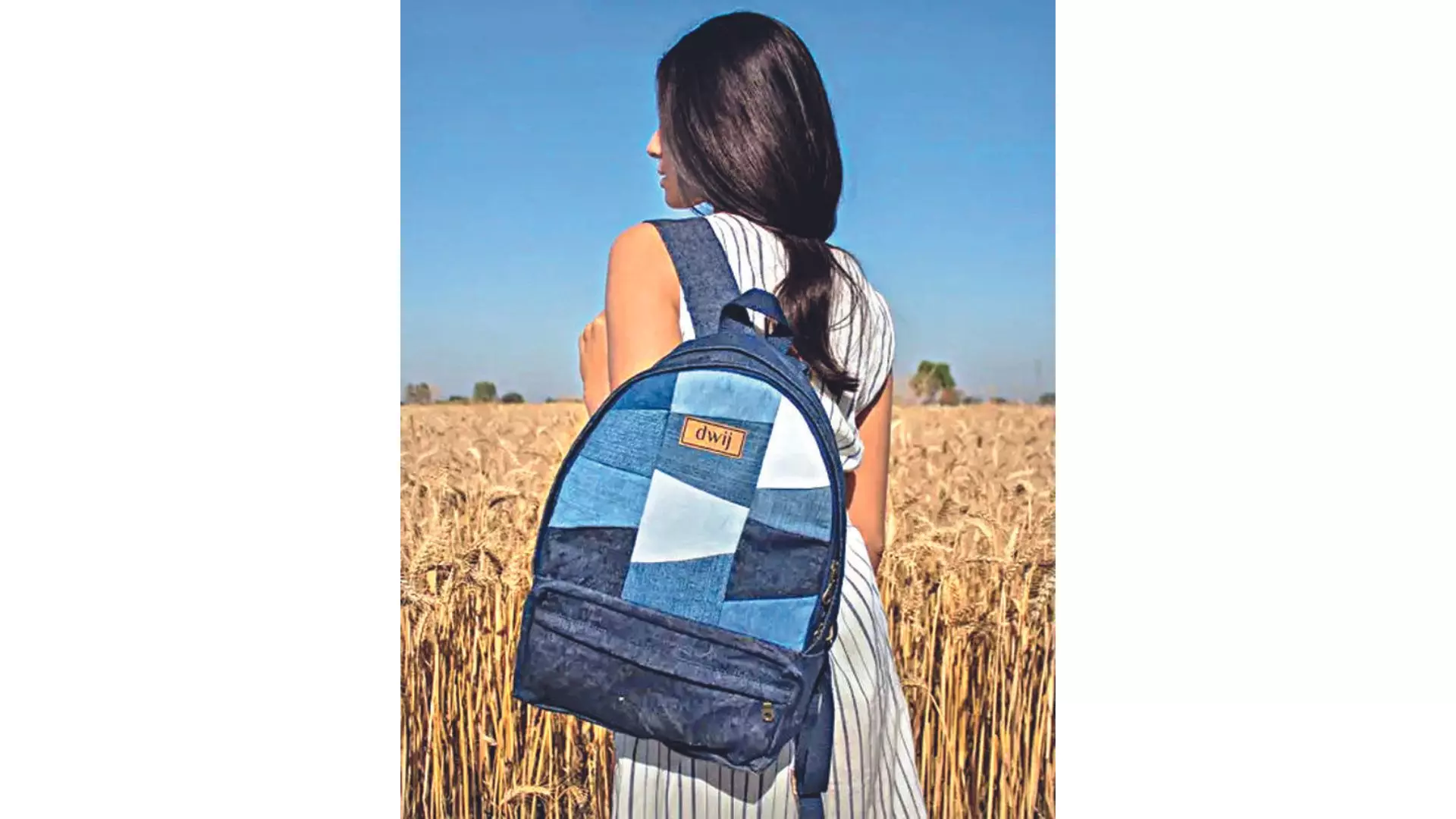Going Green is in Their Jeans
Denim is ubiquitous fashion but not very friendly on the environment, hence a bunch of enterprising youngsters are upcycling discarded denims into sustainable items like paper, sleeping bags, toys, jewellery, and travel rucksacks

Denim is a staple piece of clothing across the world. The different shades of denim jeans hold a special place in every person’s wardrobe. But behind the cool, casual look lies a not-so-cool environmental impact. Green warriors are taking matters into their own hands and turning the denim blues into green. Researchers claim that a single pair of denim jeans can have a carbon footprint ranging from 33 to 80 kilograms of CO2 equivalent emissions. Amrutha (29), a resident artist at Inspired at Fika says, “Denim is one of the most common apparels. However, people don’t usually like to reuse it unless they are interested in it. Most people are rather accepting towards repurposing denim into different items of functionality.” People discard denim due to size issues or minor issues like stains, not because the material is bad.
Denim Transformers
Cultivating cotton, the primary material in denim manufacturing requires vast quantities of water. A pair of jeans is expected to need about 2,900 gallons of water to make. Additionally, the dyeing process uses harsh chemicals that can pollute waterways. Luckily, a wave of creative minds is showing a more sustainable way forward. Amrutha who has a background in designing helped her acquire knowledge about textiles. She conducts workshops on upcycling denims into papers at ‘Inspired at Fika’. She says, “It is not just a workshop but an explorative space where I introduce sustainability to the attendees. There are also rooms to explore with natural dyes like onion skin, avocado skin, turmeric and cocoa powder to go beyond just indigo shades. It is a safe place for like-minded people to build a community beyond just learning sustainability and craft.” Denim that is 90% made out of cotton can easily be pressed, torn, soaked and grinded into a concoction with some other recycled paper. Only heavyweight non-stretchable jeans with no lycra and pure cotton are used. Amrutha explains that even a delivery paper bag can give 30 sheets of A5-sized paper. She says, “Personal interest in learning is really important to understand the overall impact of denim on the environment.”
Perfect Solution
When Nirvaan Somany (17), a student, saw the United Nations’ facebook post, stating that 10,000 litres of water is required to make a single pair of jeans it left him disturbed and horrified. “It meant that I had 50,000 litres worth of water in my wardrobe that I had not even thought of.” He then started a social initiative called Project Jeans – Blue To Green. After learning about denim's strength, durability, and insulating properties, Nirvaan decided to make sleeping bags for the underprivileged. “With my mother's help, I created a prototype from recycled denim and tested it on a winter night on my porch. I felt comfortable and warm throughout the night,” he says. Nirvaan urged his house help and guards to try it and made improvements based on their feedback. Finally, he trained local artisans, who are now skilled in making these sleeping bags.
The power of WhatsApp messaging made Project Jeans connect with media houses, schools, colleges and television networks. Express Avenue Mall (Chennai) and Parle Square Mall (Mumbai) offered to be collection centres for them.
Bajaj Electric involved almost all their branches from all over India to collect jeans as did companies like Blue Star and SRL Labs. He says, “We have managed to collect around 14,000 pairs of jeans and have distributed roughly 2,000 sleeping bags so far.”
Going Green
Imagine if you could give your jeans to a company and get an adorable toy or a sturdy bag made from it! Soumya Kalluri (31), founder of Dwij says, “Dwij means second life. Once the denims are manufactured and in the market, it is now in our control to make conscious choices in using or reusing it sustainably.” All pre and post-consumer
denims at Dwij are normally washed with no dyeing or chemicals and are segregated based on shades, sizes, the thickness of material and GSM. Dwij upcycles old, stained and worn-out denims into bags, jewellery, home goods and toys.
Along with denim, they also use recycled PET felt fabric for the creation of some of our sturdiest bags. Soumya says, “It helps to make the bags semi-waterproof and allows for disintegration of products easily, after its usage. We aim to make products that once used to full potential, can be disintegrated and repurposed further.” Dwij has so far upcycled 8,500 post-consumer jeans, 2,000m (metre) post-industrial denim/ pre-consumer denim, 2,000m post-industrial kurta/ shirt lining and 750m recycled felt.
Every journey has its ups and downs and so does the journey of sustainability for these denim transformers. Nirvaan says, “There is a financial cost to the conversion of discarded jeans into sleeping bags. It can be challenging to explain this to people and to raise money for this.”
However, Soumya says, “People are now more aware and looking for eco-conscious products. They are keen to listen to such concepts. Once you know ‘why’ then it is easier to carry the cause forward.” It’s high time you switch to a greener wardrobe or start upcycling your discarded jeans for a greener planet!
Once the denims are manufactured and, in the market, it is now in our control to make conscious choices in using or reusing it sustainably.” — Soumya Kalluri, founder, Dwij
Most people are rather accepting towards repurposing denim into different items of functionality.” — Amrutha, resident artist, Inspired at Fika
We have managed to collect around 14,000 pairs of jeans and have distributed roughly 2,000 sleeping bags so far.” — Nirvaan Somany, founder, Project Jeans - Blue to Green
